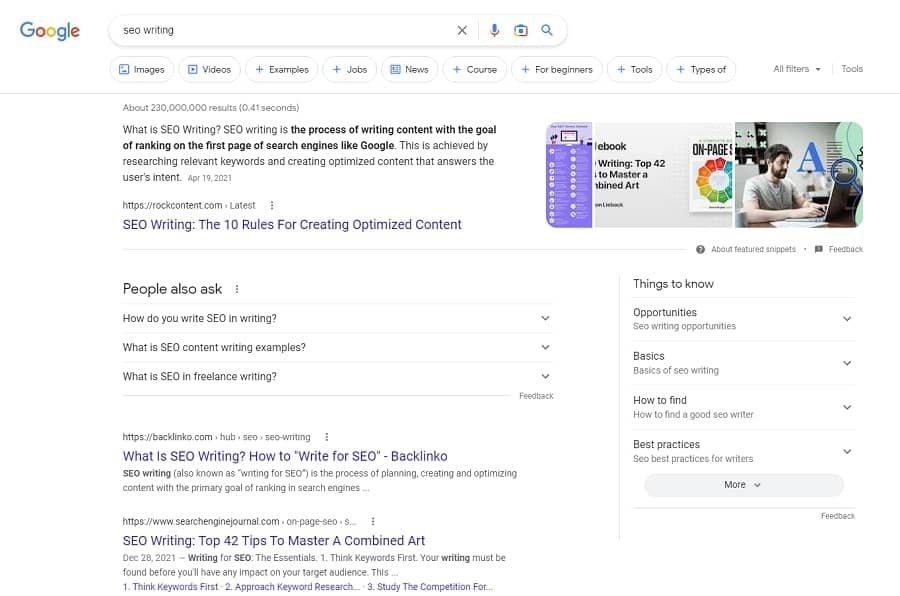Top-quality SEO writing is the lifeblood of the internet and the heartbeat of all successful websites.
Whether you’re a blogger, an e-shop owner, or you operate a brick-and-mortar business with an online component, quality SEO content is the key to search engine success.
But what’s SEO writing? Why is it essential for online performance? And how do you write well enough for SEO that Google will rank your content well?
For anyone new to the world of online content writing, these questions can be a significant obstacle, obscuring the path to clicks, conversions, and revenue for your website.
Thankfully, we’re here to help you break the barriers and learn the intricate art of SEO content creation.
Below, we’ll cover over a dozen top-tier SEO writing tips that every beginning SEO content writer should use for their online content.
Let’s jump in!

What is SEO Writing?
Before you can understand what SEO writing is, you need to understand SEO itself.
SEO, or Search Engine Optimization, is the specialized process of ensuring your website’s content meets the standards of a search engine’s algorithm.
For example, Google’s algorithm likes quality content that:
- Is easy to understand
- Displays a level of expertise, authoritativeness, and trustworthiness
- Effectively addresses people’s search queries
So, SEO writing, or “writing for SEO,” is the creation and optimization of written content to please search engines enough that they’ll rank your work well in results pages.
But why does SEO matter so much for search engines?
Why is it Critical for Quality Content Creation?
Online success depends on how many readers you can attract to your content.
However, the number of people you can attract depends on which page of the search results you rank on and how high your ranking is on the page.
For example, did you know nearly 30% of all clicks go to the #1 ranking site on the first page of Google’s search results? That’s almost a third of all traffic for a search query!
Because high Google rankings are so critical to online success, millions of blogs and websites compete for the top spots on Google’s first page.
As an online creator, producing top-quality SEO writing is the only way you’ll have a chance at ranking.
Whether you’re a casual fan of SEO copywriting or a freelancer providing clients with an SEO content writing service, it’s essential to understand the basics of SEO writing if you want to conquer online.
SEO Writing Basics: Key Terms to Note

Before we delve into the tips that beginners should know, there are several important terms to note…
Keywords
Specific phrases and words people look for in search engines and what you build your SEO content around.
Long-tail Keywords
A phrase or string of keywords that are more specific than normal keywords.
Organic Keyword Difficulty
A (1–100) score of how hard it is to rank for a keyword.
Search Queries
Words or phrases people look up in search engines.
Search Volume
The total number of times people search for a specific term in a month.
Search Engine Results Pages (SERPs)

The pages containing search results within search engines, like Google.
SERP Position
The ranking of a page within the SERPs.
Ranking Factors
Components search engines use to decide page rankings.
Backlinks
A hyperlink that directs web traffic to an external page.
Anchor Text
Phrases or words containing a hyperlink.
Organic Traffic
The number of visitors coming to a site from SERPs.
Conversion Rate
The percentage of people who complete an action (like clicking a link) divided by the number of people who visit a page.
Click-Through Rate (CTR)
The percentage of clicks on a page in the SERPs relative to the number of times searchers saw the page in the SERPs.
Meta Description

A short summary of a webpage displayed in SERPs.
Structured Data (Schema)
The formatting of elements like keywords, metadata, and HTML on a page to aid search engine crawling and indexing.
Page/Domain Authority
A (1–100) score indicating the authority of a page or site.
Pageviews
The number of times a specific page is viewed.
Dwell Time
The amount of time a person stays on a page.
Bounce Rate
The percentage of people who leave a site after viewing one page.
The Top 13 Rules For Every SEO Writer (+ Tips and Tricks to Hone Your Craft)

With an understanding of SEO content writing basics under your belt, we can explore several tips you should leverage during your online content creation.
Using these tips throughout your writing process can effectively attract Google’s attention and increase your odds of ranking well.
1. Learn the Finer Points of Keyword Research
Even if you have an excellent idea for a blog post (or several), it’s almost impossible to create ranking content without finding the right keyword. Meaning that before you start writing, you need to conduct keyword research as part of your content strategy.
Sadly, we can’t go into detail about everything keyword research entails here. We can only emphasize its importance.
Thankfully, there are plenty of excellent guides available to help you understand the ins and outs of this essential step in SEO copy creation. There are also several specialized SEO tools you can leverage to make the process more manageable.
For example, a top-quality SEO writing assistant like Ahrefs, SEMrush, Moz, or PageOptimizer Pro can help expedite your keyword research and make it easier to create content with a high chance of ranking online.
Google Analytics is also an excellent option for writers who need a quality SEO tool on a budget.
2. Know Your Audience and What They’re Searching For
This tip connects directly to the one above about keyword research.
Remember, Google ranks content that answers people’s questions and addresses their search queries.
So ask yourself, why would people put that keyword into Google? What are they looking for? And how can your content give them what they’re looking for?
When you figure this out, you can identify the “search intent,” or purpose behind their online search.
This information is critical for SEO content writing and will guide you in successfully structuring your work to target readers and please Google’s algorithm.
3. Study Your Competition and Create Detailed Outlines
Just like you can’t write about a random topic and expect it to rank well, you generally can’t create ranking SEO-friendly content without an effective strategy.
Millions of blogs and websites compete to rank highly on Google for the keywords you target. The only way to overtake them is to ensure your content is superior.
To do this, read the competing posts already ranking on Google for your keywords.
What are they talking (or not talking) about? What are some doing that others aren’t? How can you do it better?
With this information, you can develop a detailed outline of what your blog post should include, increasing your chance of ranking success.
4. Write For Humans and Search Engines

Some SEO writing guides will tell you to write for either readers or search engines, emphasizing the importance of one over the other.
But this is a critical mistake.
Creating rankable content requires you to satisfy search engines by meeting the search intent of readers — the two can’t, and shouldn’t, be separate ideas.
Think of it as a type of cycle your content needs to break into…
To please search engines, you need to please readers.
However, to please readers, you need to please search engines enough to rank your content and get it in the hands of readers.
5. Hone Your Headlines to Attract Readers
The first thing people see when your post pops up in the SERPs is its headline. Meaning your headline is a significant part of what ultimately convinces them to click on your post.
Thankfully, there are methods you can use to make your headlines more enticing, thereby ramping up your CTR.
Some of these methods, aptly called CTR-boosters, include:
- Using numbers and percentages in the headline
- Using the current year in the headline
- Using special characters, like parentheses, brackets, and ampersands
Additionally, you want to ensure your headline isn’t too long, or Google will cut it off (truncate it) in the SERPs.
You can use Google’s SERP Snippet Optimization Tool to ensure it’s an acceptable length.
6. Never Neglect Meta Information
Second only to headlines, meta descriptions are one of the first things prospective readers see when your blog post appears in the SERPs.
While meta descriptions don’t directly impact Google rankings, they can significantly impact your page’s CTR.
You also need to include an optimized title tag, which is an HTML code tag that lets you give your page a title in the SERPs.
To optimize your meta information for Google, your meta description should be fewer than 160 characters, and your title tags shorter than 70 characters.
7. Master the Art of Subheads
According to research on how people engage with web content, nearly 80% of users scan a new page before reading it. This saves people time by letting them pull out key points to learn what the post is about.
Basically, your posts need to pass a “scan test” before users decide to become actual readers.
Clear and compelling subheads make scanning easier for readers and can encourage them to stay on your page for a full readthrough of your content.
Using effective subheads also helps search engine crawlers go through your page and know what it’s about, which can lead to a higher ranking.
8. Focus on Long-Form, Comprehensive Content

When writing blog posts, it’s generally best to produce compelling, long-form content.
Longer content is better because it keeps people on your page for longer periods. Additionally, Google’s algorithm was updated years ago to prioritize longer, more thorough content while penalizing shorter content.
As a rule, you’ll want to ensure each page you create contains a minimum of 1,000 words.
Not only will this keep Google’s algorithm happy, but it gives you the freedom to provide more information to readers in different and creative ways.
9. Link to High-Authority Websites
Another major factor that influences how Google ranks pages is the presence of external links to high-quality content.
Basically, Google wants to rank pages that not only include great information and satisfy search intent, but also include links to other informative pages.
By embedding external links to high-profile (relevant) content, you can show Google that your work is connected to authoritative sites.
Meaning Google will consider your content more authoritative too!
However, this also goes the other way. You want to avoid linking to low-quality content because it’ll lower your content’s authority.
10. Link to Other Pages On Your Website
By adding internal links to other content from your own website, you can better optimize your SEO writing.
Internal links make it easier for search engines and readers to find related or relevant content you’ve published previously.
For readers, this can mean finding reasons to stay longer on your website.
For search engines, this means it’s easier to index your site’s pages.
The number of internal links you should have depends on several factors…
But you generally want to include 3–5 internal links within every piece of SEO writing you create.
11. Leverage Different Media Types
Taking a multimedia approach to your SEO content writing creates compelling posts for readers.
As a baseline, you should include relevant images in your content.
But don’t rely solely on stock images to break up your writing.
Try incorporating a mix of great content for readers to enjoy and to catch Google’s attention, including;
- Screenshots
- Videos
- Infographics
- Charts, graphs, and other visualized data.
Adding these visual elements to your SEO article will help keep readers engaged and encourage them to stay longer on your page.
12. Always Optimize Your Images

It’s not enough to upload a few images into your post, cite them, and call it good. You also need to optimize your images for SEO.
Image optimization requires several steps, but thankfully it’s not a difficult task. All you need to do is:
- Save your images in the correct format — we recommend PNG for simple images, and JPEG for images with many colors.
- Use customized image file names using the target keyword of your post.
- Resize your image dimensions.
- Compress your images using a tool like compressor.io or TinyPNG.
- Give the image an optimized title and appropriate Alt text for search engines and people with visual impairments.
- Make sure the images are mobile-friendly.
- Include image captions.
Routinely following these steps will optimize your content’s SEO, while also improving your page speed and performance!
13. Edit Everything (and Then Edit Again)
After creating your content, you’ll need to review your work with a fine-toothed comb to correct any minor (and major) issues.
We recommend going through at least two editing stages — one for substantive editing and one for copyediting.
Substantive edits involve correcting the big-picture issues.
For example, does your post satisfy searcher intent? Do sections provide the information promised by the subhead they’re under?
Copyediting involves fixing smaller issues, like spelling and grammatical errors, along with finding filler words or “fluff” to remove.
As a baseline, we recommend reading your work out loud during the editing process to help you catch issues you may not notice during a read through.
You can also use one of these great grammar checkers to ensure nothing slips through the cracks.
Get Ready to Take Your SEO Writing Skills to The Next Level

Understanding the tips and tricks needed to produce quality SEO writing is an essential skill for obtaining online success.
Using the tactics above, you can create unique, compelling content that search engines like Google want to rank and boost your blog’s traffic in no time!
If you want to access even more great ways to improve your online work…
Check out this post covering 18 other content writing tips or this post exploring six major SEO mistakes you want to avoid.
You can also explore the official Smart Blogger blog to find even more top-quality writing resources.
The post 12+ Beginner-Friendly SEO Writing Tips to Elevate Your Content appeared first on Smart Blogger.

No comments:
Post a Comment